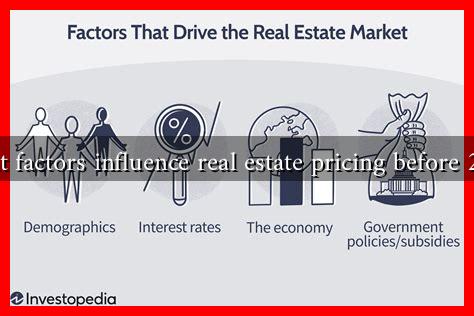-
Table of Contents
What Factors Influence Real Estate Pricing Before 2025
The real estate market is a complex ecosystem influenced by a myriad of factors. As we approach 2025, understanding these factors is crucial for buyers, sellers, and investors alike. This article delves into the key elements that shape real estate pricing, providing insights that can help stakeholders make informed decisions.
Economic Indicators
Economic conditions play a significant role in determining real estate prices. Key indicators include:
- Gross Domestic Product (GDP): A growing economy typically leads to increased demand for housing, driving prices up.
- Unemployment Rates: Lower unemployment rates correlate with higher disposable income, which can boost home buying.
- Interest Rates: The cost of borrowing directly affects purchasing power. Lower interest rates make mortgages more affordable, increasing demand.
For instance, during the COVID-19 pandemic, the U.S. Federal Reserve slashed interest rates to near-zero levels, which contributed to a surge in home prices as more buyers entered the market.
Demographic Trends
Demographics significantly influence real estate demand. Key trends include:
- Millennial Homebuyers: As millennials reach their prime home-buying age, their preferences for urban living and sustainable homes are reshaping the market.
- Population Growth: Areas experiencing population growth often see increased demand for housing, leading to higher prices.
- Migration Patterns: The trend of remote work has led many to relocate from urban centers to suburban or rural areas, impacting local real estate markets.
According to a report by the National Association of Realtors, millennials accounted for 37% of home purchases in 2021, highlighting their influence on market dynamics.
Location and Neighborhood Dynamics
The adage “location, location, location” holds true in real estate. Factors that affect pricing based on location include:
- Proximity to Amenities: Homes near schools, parks, shopping centers, and public transportation tend to command higher prices.
- School District Quality: Properties in highly-rated school districts often see increased demand and higher prices.
- Crime Rates: Lower crime rates in a neighborhood can enhance property values, as safety is a top priority for buyers.
For example, neighborhoods in cities like Austin, Texas, have seen significant price increases due to their vibrant culture, tech job opportunities, and quality schools.
Government Policies and Regulations
Government actions can have profound effects on real estate pricing. Key areas include:
- Tax Incentives: Programs like first-time homebuyer tax credits can stimulate demand and drive prices up.
- Zoning Laws: Changes in zoning regulations can either restrict or encourage development, impacting supply and prices.
- Interest Rate Policies: Central banks’ monetary policies can influence mortgage rates and, consequently, housing demand.
For instance, the introduction of the Opportunity Zones program in the U.S. aimed to spur investment in economically distressed areas, leading to increased property values in those zones.
Technological Advancements
Technology is reshaping the real estate landscape in various ways:
- Online Listings and Virtual Tours: The rise of online platforms has made it easier for buyers to access information, increasing competition and driving prices up.
- Big Data and Analytics: Real estate professionals are using data analytics to predict market trends and set competitive prices.
- Smart Home Technology: Homes equipped with smart technology can command higher prices due to increased convenience and energy efficiency.
According to a report by McKinsey, the use of technology in real estate transactions is expected to grow significantly, further influencing pricing strategies.
Conclusion
As we approach 2025, the factors influencing real estate pricing are multifaceted and interconnected. Economic indicators, demographic trends, location dynamics, government policies, and technological advancements all play critical roles in shaping the market. Understanding these elements can empower buyers, sellers, and investors to navigate the complexities of real estate effectively.
In summary, staying informed about these factors will not only help stakeholders make better decisions but also prepare them for the evolving landscape of real estate in the coming years. For more insights on real estate trends, consider visiting National Association of Realtors.


